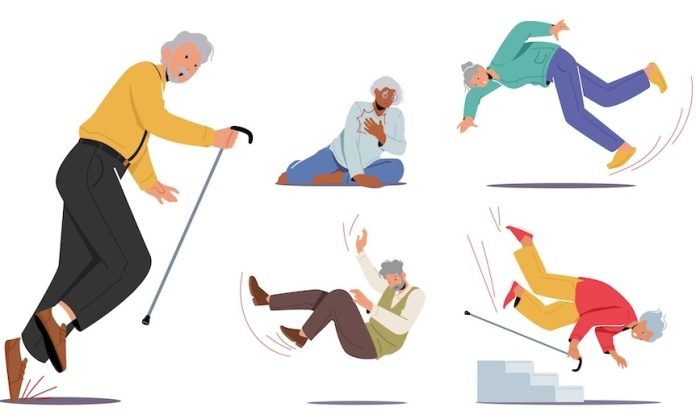
Falls are a major health concern for older adults, often leading to injuries that can affect their independence and quality of life. By understanding the common causes of falls, we can better protect our loved ones and ourselves as we age.
The reasons why older people are more likely to fall are varied and often interconnected. One of the primary causes is physical changes that come with aging.
As people get older, they may lose some muscle strength and flexibility. This loss can affect their balance and coordination, making it harder to walk or quickly react to slipping or tripping.
Changes in an older person’s gait—the way they walk—are also a factor. These changes can include a slower walk, shorter steps, or a more uneven stride, all of which can increase the risk of falling.
Additionally, as we age, our reflexes and the speed at which we process sensory information slow down. This delay can make it difficult to maintain balance or avoid obstacles, especially in unexpected situations.
Vision plays a crucial role in maintaining balance and navigating the environment safely. Age-related vision diseases, such as cataracts and glaucoma, impair the ability to see obstacles and judge distances, leading to an increased risk of falls.
Chronic health conditions are prevalent among older adults and can contribute to the risk of falling. Conditions like arthritis, diabetes, heart disease, or neurological conditions such as Parkinson’s disease and multiple sclerosis can affect balance, movement, and physical strength.
Medications used to treat these conditions can also have side effects such as dizziness or drowsiness, further increasing the risk of falling.
The environment is another critical factor in falls among older adults. Hazards such as loose rugs, wet floors, uneven sidewalks, poor lighting, and clutter can easily lead to falls. Stairs are particularly dangerous areas, especially if there are no handrails or if the steps are uneven.
Mental health issues, such as depression and cognitive impairment, can also increase fall risk. Cognitive impairment can lead to poor judgment and difficulty in recognizing and avoiding hazards.
Additionally, both depression and cognitive decline can reduce an older person’s activity level, leading to muscle weakness and balance issues.
To prevent falls, it is essential to address these various risk factors comprehensively:
- Regular exercise can help maintain physical strength and improve balance and coordination. Activities like walking, tai chi, and simple strength training exercises can be particularly beneficial.
- Regular health check-ups to manage chronic conditions and review medications for side effects that could increase fall risk.
- Improving home safety by removing hazards, improving lighting, installing grab bars in the bathroom, and ensuring that stairs are safe and have handrails.
- Vision checks to ensure that eyeglasses are current and that any treatable vision issues are addressed.
- Community and family support to encourage safe physical activity and to help make the living environment safer.
Falls do not have to be an inevitable part of aging. With proper interventions and preventive measures, many falls can be prevented, allowing older adults to maintain their health and independence longer.
Awareness and proactive management are key to reducing the risk and ensuring a safer environment for our aging population.
If you care about health, please read studies about Vitamin nutrient supplements may increase fall risk in people with diabetes and these vitamins could help reduce bone fracture risk.
For more information about wellness, please see recent studies that Krill oil could improve muscle health in older people, and Jarlsberg cheese could help prevent bone thinning disease.
Copyright © 2024 Knowridge Science Report. All rights reserved.



